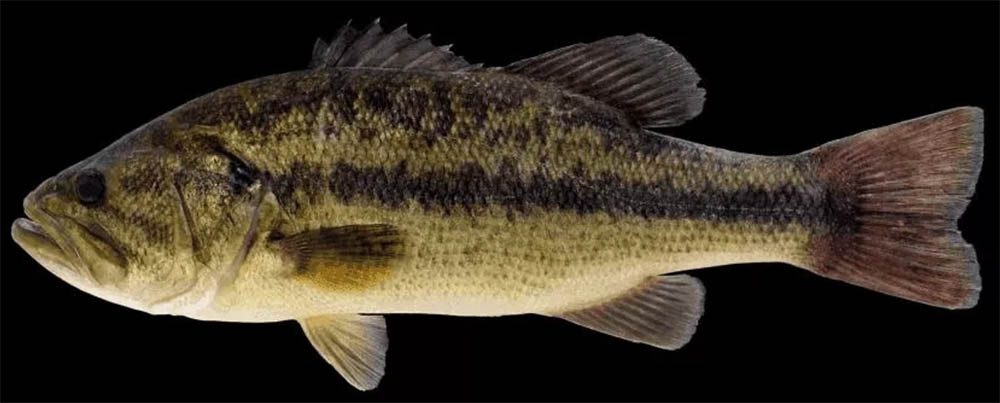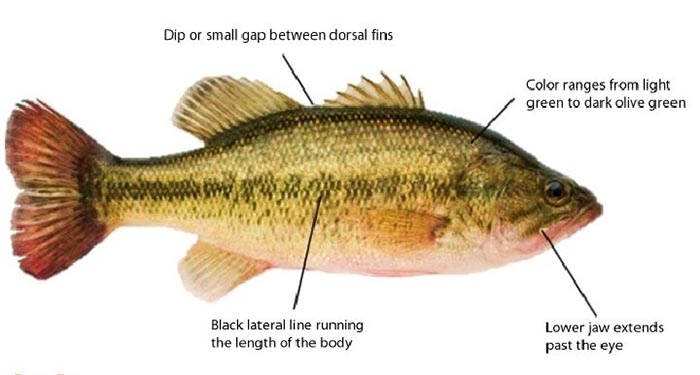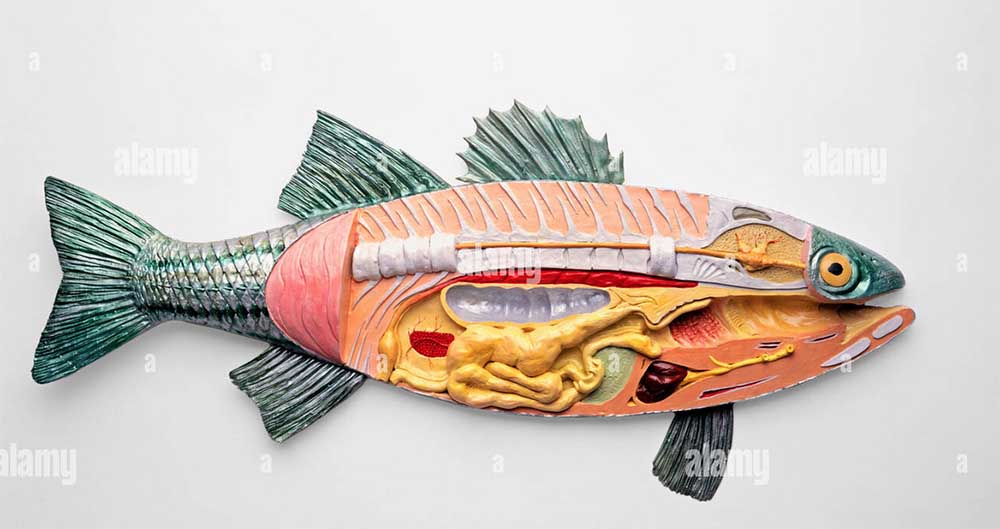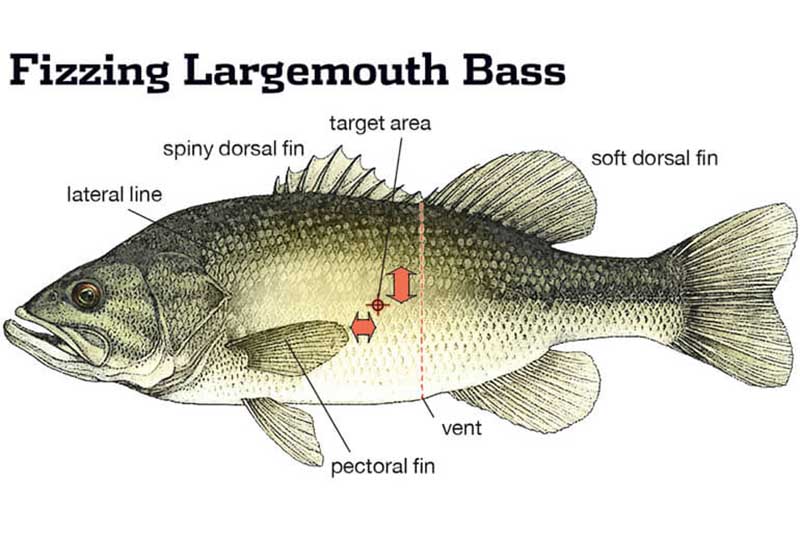Largemouth Bass: Sometimes, It’s OK to Judge a Book by Its Cover
Body shape
As a general rule, long and sleek means fast, and you can see that maxim clearly exercised when you take a look at fish like the pike or barracuda. Streamlined means hydrodynamic, and the more a fish is shaped like a torpedo or rocket, the faster it’s likely to be.

By contrast, the largemouth bass is no speed demon.
Instead, its sleek ovoid shape is Mother Nature’s compromise between quickness and maneuverability, allowing it to accelerate and turn well.
Keep that in mind as you judge the best speeds to retrieve a crankbait. While you can’t outpace a bass, you can retrieve a lure so quickly that the bass decides it’s not worth the effort!
Fins
The largemouth possesses a large caudal or tail fin that provides plenty of thrust. As a result, it can go from standing still to full speed quickly, allowing it to ambush prey from cover.No real rival for the pike on this front, bass are still more than capable of taking prey from a standstill, and if necessary, chasing even the most maneuverable species down, however they twist and turn to escape.
There’s a lot of misinformation about the bass’s top swimming speed, but wildlife biologists say it tops out at about 2.5 times body length per second. As James Davis and Joe Lock note, “This means that small fish swim about 2 miles per hour while a 20-inch fish may swim in spurts of up to 12 miles per hour.”Compare that to the blistering 36 mph set down by barracuda, and you see what a difference body shape and fin structure make!
Gills
Like all fish, bass use their gills to filter oxygen from the water.

While stationary, they can move their large gill plates to pump water over their gills, staying well-oxygenated as long as dissolved oxygen reaches 8 to 9 parts per million (ppm). Most shallow lakes and ponds easily meet these requirements, but stagnant water and algae blooms can quickly reduce this number, stressing or killing largemouth bass.
Eyes
We’ve written extensively about the largemouth’s sense of sight before, and if you want the full run down, check out this article. Just by examining the head of a largemouth, you can discover an important fact about the bass’s eyesight.

Each eye is placed forward on the head but separated by the ridge of the skull. As a result, unless the bass is facing its target, it can only train one eye on what it sees.
In practice, this means that bass use their eyes first for early detection, keeping an eye out for predators as well as prey. Once they see something that might make a meal, they’ll turn to train both eyes on it, providing binocular vision with exceptional depth detection.
Another thing you’ll notice is that the bass’s plump body impedes its range of vision, especially to the back and below. That helps to explain why bass prefer to back into cover that protects them from the rear, and why they tend to feed upward rather than below.
Nares
Bass have nostrils, but they only use them to smell.

Breathing happens entirely in the gills, and the nares are only there to provide open access to olfactory organs. These are pretty advanced in the largemouth, and scientists think that bass have a more advanced sense of smell than even dogs.
But the largemouth is no catfish, and while it can sense the presence of prey items by scent, it’s a sight predator that uses hearing and vibration as secondary hunting senses.
Mouth
The largemouth’s capacious, extendable mouth gives it its name, and you can bet that it shapes its behavior.
Capable of swallowing much larger prey items than their body size suggests, the largemouth’s mouth works in conjunction with its gill rakers.
Gill rakers are comb-like structures that block exit from the gills, and any fish small enough to slip through them is too small to be of any worth to a bass. Since these rakers grow as the bass does, that means that minimum prey size increases as a largemouth matures.
On the other side, a bass’s mouth grows, too, allowing it to take larger and larger prey.
These two factors can be compared, allowing you to get a good sense of the minimum and maximum pretty sizes at various points in a largemouth’s life.
Lateral line
Bass possess a super sense for vibration driven by a structure called the lateral line.

As Chris Horton, a wildlife biologist, explains, “The lateral line is a series of pores or canals in a row of scales that stretch from just behind the gill plate to nearly the tail in a bass. They are perceptible, but you have to look closely. These canals contain a series of cells that have hair-like extensions surrounded by a gelatinous substance, together called neuromasts. Vibrations from surrounding water on one or more of these groups of cells send a signal to the bass’ brain that — along with the same effects on the inner ear — it interprets as sound.”
We’ve had quite a lot to say about how this sense works for largemouth, as well as which lures are best for stimulating a strike. Check out this article if you want to know more.
The short version is that the lateral line, while sensitive enough to detect the vortices and trailing swirls left by bait fish as they swim, is very, very short-ranged. With about 6 feet or so, it can pinpoint prey items, identify them, and even reveal their path and turns. But beyond that, it can’t really pick up much against the background clutter.
Inside Information: Largemouth Bass Internal Anatomy

Stomach, intestines, heart, gallbladder, spleen, liver, kidneys
Largemouth bass possess the same basic organs as all animals: a heart to pump oxygenated blood from the gills, a stomach and intestines to digest food, a gall bladder to store fat-dissolving bile, kidneys to filter waste, a spleen to help it fight infection and filter dead red blood cells from the blood, and a liver to produce bile and regulate the body’s chemicals.
There’s really nothing remarkable about these organs that anglers need to know about.
Brain
When scientists take a close look at the largemouth bass’s brain, it reveals quite a bit about how bass understand their world.
The size of the parts of their brain that process vision are relatively huge, followed by elements that comprehend sound and vibration. This places priority clearly on sight, with sound as a backup to their primary hunting sense.
Taste and smell are allocated in much smaller regions, and though they matter - bass will sometimes spit out a bad-tasting lure - they’re not nearly as important for detecting prey and triggering a strike.
What does this tell you?
In clear water, a lure’s shape, color, and pattern are the most important things to consider. Vibrations and sound are good, but probably not as critical.
In low visibility, however, pick what you throw based on sound and vibration.
Swim bladder
The swim bladder is an air-filled sack that fish use to provide neutral buoyancy as they change depth. By inflating or deflating this organ, bony fish like the largemouth can stay at their desired depth without floating up or sinking down. This saves massive amounts of energy, as they don’t need to swim to stay put.
Three things are critical to understand about the swim bladder.
Think of the swim bladder as a sense organ
First, the swim bladder functions as a kind of sense organ. A bass’s swim bladder is essentially a balloon just below the spine and behind the exterior lateral line. As vibrations pass through the water and strike the lateral line, they also cause the swim bladder to vibrate. This enhances the sensation of vibration, increasing the sensitivity of largemouth bass to noises and water-disrupting stimuli of all kinds. Essentially, the swim bladder is an extra sense organ, adding just that much more information about potential prey or predators.
Barometric pressure and the swim bladder
Second, barometric pressure affects the pressure in a bass’s swim bladder.If you’ve ever had your ears pop when you descended quickly, or felt the pressure build on your eardrum when you were at the bottom of a pool, you know exactly what I’m talking about.As barometric pressure drops - a phenomenon usually associated with bad weather, clouds, and rain - the largemouth’s swim bladder will expand uncomfortably.
That sensation will turn off feeding and push them to find a more comfortable depth to equalize that new pressure.
As Spud Woodward, Assistant Director for the Georgia Department of Natural Resources Coastal Resources Division, explains, "Fish with large bladders quickly sense when the air pressure is dropping, because there's less pressure on their bladder. And when there's less pressure squeezing their bladders, the bladders expand a bit. When their bladders expand, fish become uncomfortable. They relieve their discomfort by moving lower in the water column or by absorbing extra gas in their bladders.”
Bass can’t just expel that gas; it has to be slowly absorbed, pushing them to change depth until they can relieve their discomfort. And they’ll stay there, riding out the low pressure, rather than feed.
If you’ve ever had a bad stomach ache, you’ll remember just how interested in eating or exercising you were. Bass feel much the same way.
“Because of the anatomical and physiological stresses exerted on them, they're not worried about eating,” Woodward says. “They're more concerned with trying to find a depth where they can stabilize their bladder pressure and feel good.”
That’s why a sudden drop in barometric pressure can turn off the bite.
The swim bladder, barotrauma, and fizzing
If you were to descend to 30 feet or so and partially inflate a balloon with air and then let it go, it’d rise through the water column (of course). As it does, it’ll continue to inflate, growing in volume quite a bit as it heads toward the surface.
That’s because it’s a closed system, and while at depth, the water pressure is pushing on all sides, forcing it into a smaller, tighter shape. But when that pressure decreases as the water gets more shallow, the air inside the balloon will increase in volume, potentially even bursting the balloon that was only partially full a few feet below.
The largemouth’s swim bladder isn’t truly closed, but there’s no mechanism for quick adjustments. As a result, dramatic changes in depth can cause the internal pressure of the swim bladder to skyrocket, potentially causing injury called “barotrauma.”
As Gene Gilliland puts this, “Bringing bass to the surface from deeper water results in a rapid expansion of the bladder because of reduced water pressure – a condition called ‘barotrauma.’ This condition is more commonly an issue when fish are caught at depths greater than 20-30 feet, but symptoms can exhibit themselves as a stress reaction in fish caught from much shallower water.”
The result can be a dead bass.After you drop it in your live well or release it back into the water, if your bass can’t stay upright and rolls to the side, you may have a serious problem on your hands.Doing nothing is not a good option.
The solution is a technique called fizzing, in which you release the trapped excess air from the largemouth’s swim bladder.You need a 1 1/2-inch-long, 18-gauge hypodermic needle and just a touch of anatomy to get the job done.
The idea is to pierce the swim bladder and release the excess without puncturing anything vital. That’s not as hard as it sounds.Imagine two lines. The first runs from the anal vent to the notch between the two dorsal fins. The second runs from the pectoral fin straight back along the bass.
Where these two lines intersect, you’ll find the swim bladder. You insert the needle almost flat, sliding it under a scale. Then, turn the needle upright and press it home to the swim bladder. If you do this last step with the fish underwater, you’ll see the air escaping and know when you’ve done enough.







